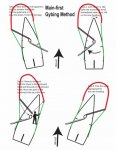Channel Sailor
Active member
After a bit of guidance please. Should the Pole be released from the mast ring only first, then that end made on the new guy, then release from the old guy, then secure this Pole end on the mast ring. The spinnaker clews being spaced apart by only the width of the pole for a short while. This what I currently do.
Or
Release the pole at both ends at the same time which means the spinnaker can set wider along the foot?
I can use guys and sheets, or sheets and tweakers if that makes a difference to the answer.
Or
Release the pole at both ends at the same time which means the spinnaker can set wider along the foot?
I can use guys and sheets, or sheets and tweakers if that makes a difference to the answer.


